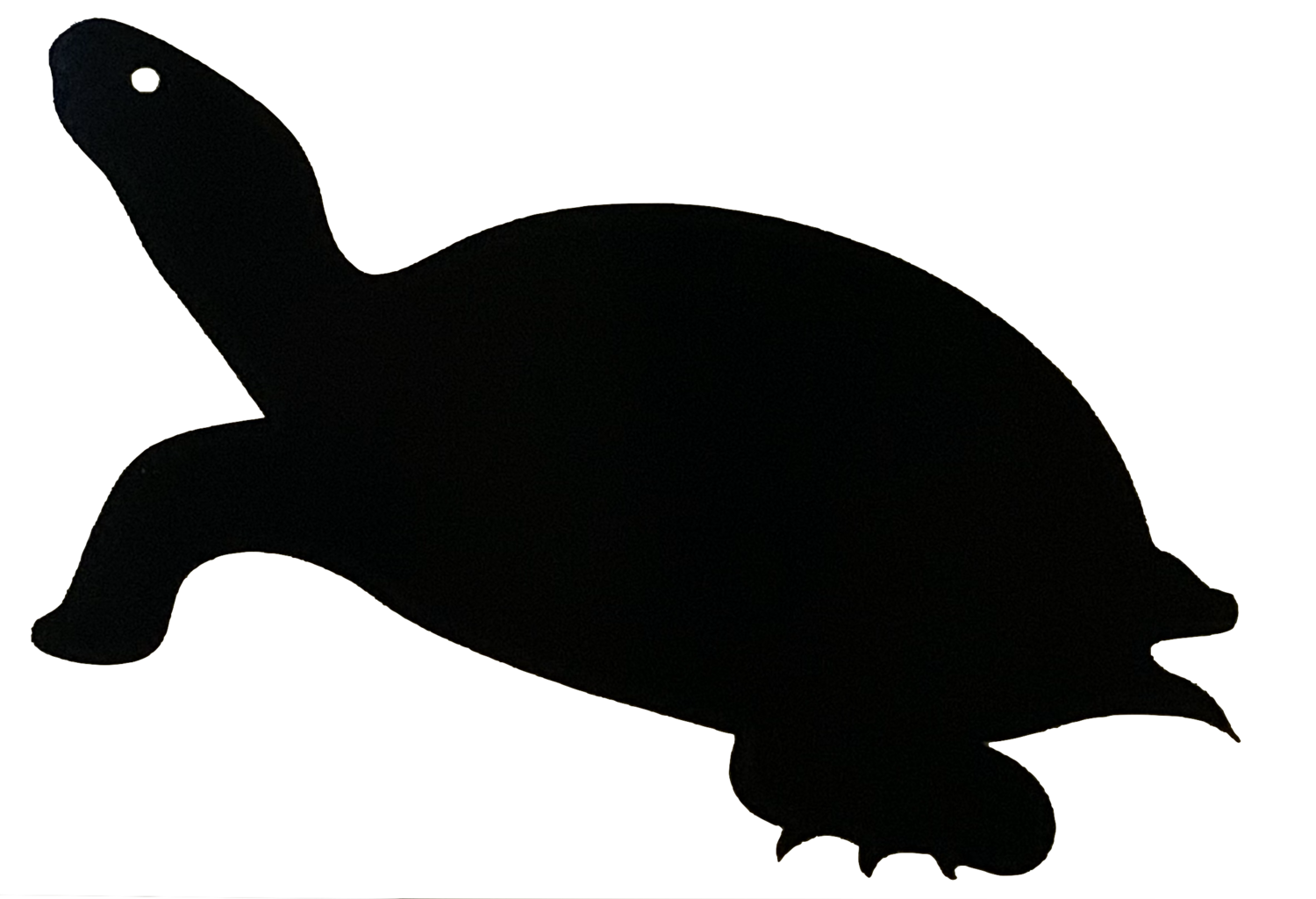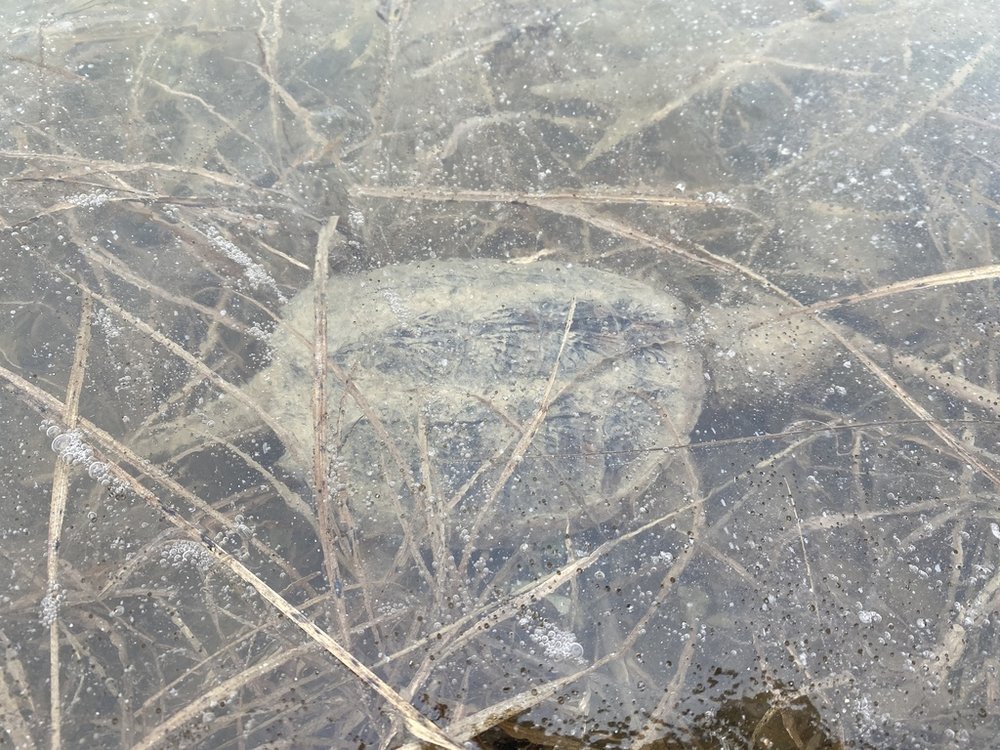Turtles in Winter
Snapping Turtle under the ice in January in southern Ontario. (Photo source: iNaturalist Canada, photo by Lucas Foerster is licensed under CC-BY-NC) https://inaturalist.ca/observations/67912926
Generally, spring through to late summer is considered “Turtle Season”. When autumn and winter roll around, thoughts veer away from turtles. Do you ever wonder what our turtle friends are doing during the cold of winter? Let’s find out!
What happens to turtles in sub zero temperatures?
During the winter months, Ontario turtles go into a form of hibernation called brumation. Brumation refers to the hibernation of cold blooded (ectothermic) animals like turtles that depend on their surroundings for body temperature.
During brumation, turtles conserve energy by decreasing their temperatures, as well as their heart rates. During this time, since turtles are using minimal energy, they do not need to consume food or move around. However, during brumation, turtles still have control of their muscles and they are conscious.
Did you know? Turtles can slow their heart rates to almost nothing! During brumation, they can actually reach a point where their heart is only beating ONCE per 10 minutes.
Are turtles asleep during their brumation?
Despite many animals being asleep for the winter, turtles seem to be aware of their surroundings even in their ‘shut down’ states. Overwintering turtles have been spotted moving around under the ice, even coming up for air during mid winter thaws when temperatures rise. During certain studies, turtles have reacted to overhead drones and changes in sunlight even from underneath the top layer of ice.
Where do the turtles spend winter?
Turtles brumate at the bottoms of lakes, ponds, or deep under the mud. It is important to note that locations in which turtles spend the winter still have to have oxygen, as turtles cannot survive without oxygen, even during brumation. For example, if a turtle were to overwinter in a shallow pond, the turtle would die if the pond froze to the bottom since they would not be able to get oxygen from the water.
An important note!
NEVER remove a turtle from the wild in an attempt to keep it warm for the winter. Not only is it illegal to confine an Ontario turtle or keep it as a pet, it disturbs their natural cycle. Turtles need their winter rest period. It is imperative that we do not interfere. Never relocate a turtle to what you may perceive as a ‘better’ spot - a turtle is always better left in the territory it was found!
How do turtles breathe underwater during the winter?
When turtles are at the bottom of a lake/pond for the winter, they still need to take in oxygen. Fortunately, water at the bottom of these water bodies is actually warmer and more oxygen rich than the surface water. And fortunately, turtles don’t have to breathe through their mouths while brumating as they have adapted the ability to also ‘breathe’ through their tail opening via a special tissue. This is called “cloacal breathing” as the oxygen in the water is passing over their cloaca (rear end). This version of breathing is actually a version of respiration that is gas exchange, not technically breathing.
Are turtles safe during the winter?
Turtles on the move crossing roads during the summer may seem like the riskiest time of their lives; however, winter has its own risks. Turtles are vulnerable when their systems are slowed down to spare energy. For example, they are at a high risk of sickness because with the slowing of their bodily functions, their immune systems are also partially shut down. If a turtle was injured during the year, it is very dangerous for it to burmate, as its body will not have the strength or energy reserves to heal the injury.
Other dangers include, if the layer of ice on the surface of the water is frozen for too long, oxygen under the water can become depleted and cause the overwintering turtles to perish. If the pond freezes solid, the turtles underneath the mud or at the bottom will die.
In addition, any human activities in the water also pose a risk to turtles during winter (e.g. construction of docks or bridges etc.). In fact, entire populations of turtles could accidentally be killed by human in-water activities in winter. This is particularly true for map turtles as they are known to brumate in groups (although the reason for this is unknown).
Can turtles live without oxygen?
Some survival methods vary by species. For example, snapping turtles and painted turtles (exclusively) can shift their metabolisms to temporarily stop requiring oxygen. This is a last resort, as going into this mode without oxygen affects their overall well being. Shifting their metabolisms into an oxygenless state creates acidic toxins in their bodies that dissolves calcium from their shells. This can lead to a calcium deficit, so although it is incredible that certain species can go completely without oxygen for a time, it is only as a last resort.
Northern Map and Wood Turtles require higher levels of oxygen than the other species in Ontario. This makes seeking winter accommodations more difficult for them. In order to have a higher amount of oxygen for survival, these species seek out rivers and moving water for their winter hideouts, as flowing water contains more oxygen.
Did you know? Although it may seem counterintuitive, Blanding's turtles in Algonquin Park have been known to seek out the COLDEST areas (still staying above zero) in their overwintering location. Researchers have found that they do this in order to slow their metabolism as much as they possibly can. Blanding’s turtles need less and less oxygen the slower their metabolism is, so they seek out colder areas in the wetlands, because being even 1 degree too warm could mean the difference between life or death due to oxygen requirements.
What happens when turtles come out of brumation?
When air and water temperatures rise in the spring, the turtles nestled away in the mud will experience the temperature rise and their metabolisms will slowly begin rising as well. Turtles will emerge from the muddy depths and seek sunlight and basking spots to raise their body temperatures.
CALL TO ACTION!
If you have a backyard pond or pool, be conscious of the wildlife and REMOVE turtles that may have moved into your pond. Some bodies of water - especially human made ponds - are simply not deep enough for creatures to overwinter. This is especially true for ponds that have a layer or liner at the bottom. Turtles and frogs can attempt to overwinter, but cannot protect themselves by burrowing deep into the substrate. Keep turtles out of your shallow ponds, or drain them in the fall to prevent turtles and other reptiles/amphibians from attempting to overwinter there. NEVER remove a turtle from its natural habitat or territory to place it in your pond. It may seem appealing to have turtles living in your pond, but you can inadvertently become responsible for their failure to survive the winter by placing them in an unnatural or unsuitable body of water.
In conclusion, we hope you share in our amazement at the incredible hardiness of turtles during the winter. Each species is different, but they all have ways to seek out the best chance of survival. As turtle warriors, we have a responsibility to avoid creating environments in which they may have a false sense of survival security and allow turtles to seek out the best, natural accommodations. When you’re tucked up in your cozy home this autumn and winter, don’t forget about the turtles that are expertly sheltering all around us!
Sources: Portercountyparks.org; Ontarioturtle.ca; Blog.cwf-fcf.org

